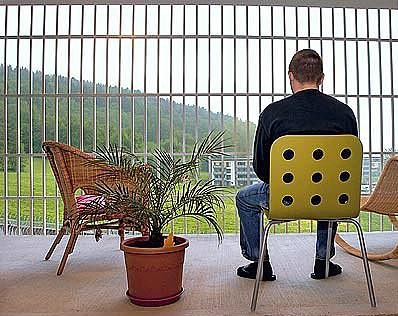Posts Tagged ‘prisons’
Posted on: December 31st, 2013 by Waterloo Region Crime Prevention Council
I just love this time of January when you get to take a look back at what’s been accomplished over the past year, ponder what worked well and scratch your head about what emerged that you never expected.
As we turn the page into 2014, I also love the tradition of digging into our blog to find what you, the readers, found most interesting over the last year. With over 45 blog posts in 2013, there was certainly something for everyone. We had 23 different guest bloggers contribute community responses on the root causes of crime as part of the Snapshot in Time: Root Causes of Crime in Waterloo Region. You can find all the posts and community responses in one tidy corner of the blog.
But, our readers are diverse which indicates why our most popular blogs on Smart on Crime ranged from book reviews to casinos and from guest commentary to provincial budget analysis. Here’s the round up of our top 13 posts from 2013.
1. The local impact of youth unemployment/underemployment – guest post by Carol Simpson
“If youth in the labour market cannot find employment, they find it increasingly difficult to become established in the “adult” world. They have done nothing wrong. They have done what they were told to do and were supposed to do yet cannot find that suitable connection to the workforce. This impacts their confidence and their ability to “fit in”. Many have chosen to give up and have simply walked away from the labour market making it even harder to find their “place” in the world. This results in frustration and anger and they feel neglected.”
2. What we’re reading: Rescuing Policy – by Anthony Piscitelli
“How can government solve the complex issues facing society?”
3. Children in care in Waterloo Region: Compounding risk for vulnerable children – by Jill Stoddart
“Children living in the care of the child welfare system have a higher likelihood of justice system involvement in comparison to children living with their biological parents”.
4. Excuse me Waterloo Region, your homelessness is showing – by Lynn Macaulay
“I feel part of a sector where I join in solidarity with people experiencing homelessness and many community members who together stand up to say – people who are homeless matter. We collectively are committed to ending homelessness in Waterloo Region. This is a lofty goal, which will take much persistence and hard work, but with the determination and skills of this community, I believe it is possible.”
5. Income of low income families: Root cause of crime in Waterloo Region – by Anthony Piscitelli
Neighbourhoods that are at an economic disadvantage when compared to other areas report higher crime rates. In addition, societies where wealth is concentrated amongst a small group of individuals report higher crime rates.
6. Through the eyes of crime prevention: Ontario 2013 Budget – prepared by Alexadra Kraushaar

7. The day I went to prison – by Andrew Jackson
“Five minutes later I stood at the front of a classroom with 25 women waiting for me to start talking. “Good morning” I said. “Good morning.” came the reply from the women of Grand Valley Institution for Women (GVI).”
8. Knowing other people care: The importance of community to women who have experienced homelessness – by Elizabeth Clarke
“It goes almost without saying that the overarching cause of homelessness is poverty, but not all people who are poor become homeless. Not all people who become homeless stay that way for long.”
9. Waterloo Region’s Catholic Schools: Laying a solid foundation for student success – by David DeSantis
“It is no surprise that the length of involvement in schooling significantly impacts participation in criminal activity and the probability of incarceration, as found in Snapshot in Time: Root Causes of Crime in Waterloo Region. In fact, this has been well-known in the education sector for many years – which explains the great lengths to which school boards go in mitigating against this problem.”
10. 7 things we learned from Alan Quarry about social media for social change – by Juanita Metzger
“Creating change that lasts happens in relationships, from one person to another, and these days, often facilitated with the power of social media. Here are Alan’s 7 best thoughts on the principles for engaging people in change.”
11. A Snapshot in Time: The Root Causes of Crime in Waterloo Region – by Anthony Piscitelli
“The Waterloo Region Crime Prevention Council believes monitoring the root causes of crime can aid the community in addressing crime, victimization and fear of crime through awareness, discussion, leadership and action. Once the root causes are understood more clearly, resources can be applied to areas where the community is doing poorly. A Snapshot in Time: The Root Causes of Crime in Waterloo Region identifies the root causes of crime right here in Waterloo Region and provides a tool to aid local policy makers in targeting interventions to where they are most needed and where they can have the greatest impact.”
12. Poverty in Waterloo Region… Is that REALLY OK with you? – by Mary MacKeigan
“The data in the section of Root Causes of Crime in Waterloo Region titled Income of Low Income Families is no surprise to those of us who are familiar with poverty-related issues in our regional community. In fact, in Waterloo Region, 36 earners make more than $2.57M; 360 make more than $685K; 3,610 (the top 1%) make more than $396K. Individuals who make more than $81,200 are in the top 10%. On the other hand, the median income of the bottom 50% is $14,100!* In 2007, one third of employed individuals were earning $14.00/hour or less. This is poor – it may not be deep (or absolute) poverty, but it is precariously close to it. “
13. What are the odds? The vulnerable child of today as the problem gambler of tomorrow – by Chris Sadeler
“The official position statement of the Waterloo Region Crime Prevention Council given at a public consultation on the question of a casino in the City of Kitchener. The remarks were given by WRCPC Executive Director, Christiane Sadeler on behalf of the Waterloo Region Crime Prevention Council.”
So many great reads from 2013. But if you’re in the mood for something to watch, rather than read, might I suggest our personal favourite, “Won’t you be my neighbour?” Who can resist Anthony Piscitelli’s homage to Mr. Rogers!
We look forward to bringing more great smart on crime blogs for you to ponder. Better yet, we love hearing your comments, reactions and responses to the posts and guest commentaries. We look forward to hearing more from you in 2014!
Posted on: October 16th, 2013 by Smart on Crime
I stood at the gate in the large fence waiting for someone to notice me. “How can I help you?” came the voice over the intercom. “My name is Andrew Jackson. I’m from the Accelerator Centre and I’m here to run the Entrepreneur Session.” I replied. The gate buzzed and I walked through the gate, went up the path and entered the building. I handed over my identification, signed in and then passed through a metal detector. Five minutes later I stood at the front of a classroom with 25 women waiting for me to start talking. “Good morning” I said. “Good morning.” came the reply from the women of Grand Valley Institution for Women (GVI).
This past Saturday was the third year I have gone to Grand Valley Institution as a representative of the Accelerator Centre in order to deliver four 2-hour sessions over two weekends to the women. It has quickly become a highlight of the year for me and the numerous volunteers that help teach the course.
The Accelerator Centre is a business incubator for tech companies where we are paid to provide facilities and programming in order to help start-up companies speed up the process of becoming large, sustainable, revenue generating entities. So the inevitable question is “Why do you go to Grand Valley?” The short answer is: “because the women let us.”
Three years ago Jessica Hutchison, a hard-working and passionate person from the Region of Waterloo, approached the Accelerator Centre to see if we would be interested in presenting an entrepreneurial course to the women at GVI. After some internal discussions we agreed we would do it.
Our first chore was to figure out what the content of the sessions would be. We have done presentations numerous times before on why people should become entrepreneurs and the skills and knowledge they need to do so. It was very important to us that we didn’t simplify our sessions for the women but instead we tailored the information to make it appropriate for women who would be looking to form their own company when they left GVI or would be looking to set themselves up for employment after some tough times.
The next thing to do was figure out who would come with us to present the material. Again, it was important to us to bring the same top-notch, experienced people that we would use for any of our presentations. We are very lucky to have CEOs and upper management level people volunteer their weekend time and join us at Grand Valley. As I tell the women, we bring the best available people because we believe they deserve the best available people.
The first year we attended GVI we had 12 women attend the course. The last two years we have had 24 and 25 women, respectively, attend. The women are respectful and polite and ready to learn. None of them have to be there but they choose to be and that means a lot to us.
It is our hope that we are providing the women of Grand Valley Institution with some knowledge that will empower them upon their release. We know that they are in GVI for a variety of reasons and the courts have decided they warranted some form of punishment. But we also know that when they are released from prison they deserve every opportunity to reintegrate into their communities in a positive way. I look forward to the day that I can enter a business that is owned by one of the women that attended our Entrepreneur Sessions.
What impact has this experience had on me personally? Well, this past Friday I had the opportunity to talk to the Waterloo Region Crime Prevention Council about our involvement with the Grand Valley Institution. I am proud to let everybody know about the awesome feeling I get when I see the smiling faces on the women as we shake their hands and give them a certificate of completion for our course.
I had to stop talking three times to choke back my tears. But please keep that part quiet.
 Sharing the story of the Accelerator Centre with 50 Friends of Crime Prevention
Sharing the story of the Accelerator Centre with 50 Friends of Crime Prevention
Author: As Vice President, Client Services, Andrew Jackson leads the educational curriculum for Clients at the Accelerator Centre. In addition, Andrew manages the celebrated in-house mentorship program, an essential component of the Accelerator Program. As clients seek to grow their business knowledge and develop essential skills, Andrew connects them with the resources necessary for their business to achieve long term success.
Posted on: June 12th, 2013 by Waterloo Region Crime Prevention Council
The 2013 Ontario Budget was passed in the Ontario legislature on Tuesday June 11, 2013. The Waterloo Region Crime Prevention Council always looks to the budget through the ‘smart on crime’ lens of crime prevention. The 2013 budget presents some interesting spending and ‘non-spending’ as it relates to crime prevention. We look for information with an eye for the root causes of crime which are economic factors, social environment and family structures. The economic factors we look for include poverty, employment & educational opportunities, and housing. The social environment relates to social inequalities, support to families and neighbourhoods, accessibility to services, and children & youth well-being. The family structures may include parenting challenges & conflict, parental, spousal or children criminality, lack of communication, respect and responsibility, abuse or neglect of children, and family violence.
 We have reviewed the budget and analyzed where it will directly or indirectly affect crime prevention through the root causes of crime. Here are few key highlights supporting crime prevention:
We have reviewed the budget and analyzed where it will directly or indirectly affect crime prevention through the root causes of crime. Here are few key highlights supporting crime prevention:
Health: Health is an important category to crime prevention because it targets the social environment which individuals live and supports family structures.
- Funding growing to $93 million per year by 2013-24 for the Comprehensive Mental Health and Addiction Strategy which focuses on
- Early intervention, community-based counseling, employment training, supportive housing, prevention of and treatment for substance abuse and problem gambling
- Developing a narcotics monitoring system to reduce the abuse of prescription narcotics and controlled substance medication
- Creating 23 health care links across the province to encourage greater collaboration and coordination by a patient’s different health care providers
Education: Education is an all around important part of crime prevention. It supports better economic factors, by increasing an individual’s chance for employment and health. It also provides a better social environment and leads to stronger family structures.
- Government will work with the education sector to broaden measure of success to include higher-order skills such as:
- Character, citizenship, communication, collaboration and teamwork, critical-thinking and problem-solving, creativity and innovation, entrepreneurialism, connection to postsecondary education and careers
- $12.6 million over 3 years for the expansion of summer learning programs
Employment: Employment is very important for improving economic factors; it leads to a positive social environment and better family structures.
- $195 million over 2 years for the Ontario Youth Employment Fund
- Employment opportunities for 25,000 youth in Ontario
- $200 from the first employment earnings can now be saved by recipients of Ontario Works and ODSP
Poverty: Poverty is directly linked to economic factors that may cause crime. Addressing poverty help to reduce economic factors that may lead to crime and improve the social environment in which people live.
- Reduce child poverty by %25 by continuing the 5-year Poverty Reduction Strategy, which includes:
- Ontario Child Benefit, full-day kindergarten, tax relief
- 5-year extension of the Investment in Affordable Housing program announced in the 2013 federal budget, this should provide funding for:
- Construction & renovation of affordable housing units, home ownership assistance, rent supplements, shelter allowances, renovation & repair of accommodation for victims of family violence
Aboriginal Peoples: Aboriginal Peoples are a large part of our population and are an important factor in preventing crime. Support and improvements to Aboriginal Peoples directly affects all the root causes of crime – economic factors, social environment and family structures.
- $5 million per year to improve student achievement and explore strategies for successful transition from on-reserve schools to provincially funded schools
- Develop a multi-year Aboriginal Children and Youth Strategy, which will focus on:
- Building community driven, integrated and culturally appropriate supports to help Aboriginal children and young people group up healthy and reach their full potential
- $4 million for 40 front-line positions for First Nation police services
Policing and Crime Prevention: policing and crime prevention are key ways to prevent crime directly. Funding and support are essential in order to create a social environment in which people feel safe and productive, improving economic factors and creating positive family structures.
- $12.5 million annually for Provincial Anti-Violence Intervention Strategy and the Toronto Anti-Violence Intervention Strategy which focus on:
- Intervention, prevention, enforcement, and community mobilization strategies such as dedicated neighbourhood police officers
- Currently 17 police services participate in PAVIS
- $30 million over 3 years to Legal Aid Ontario, strengthening the capacity of Family Law Service Centres and other community legal clinics across Ontario
Children and Youth: Children and youth are the future of society and are directly related to crime prevention. In order to improve the future economic factors, social environments and family structures we need to work directly with the children and youth within our society.
- Ontario Early Year Policy Framework – implement full-day kindergarten and support child care system
- Youth Action Plan (& Premier’s Council on Youth Opportunities) – increase the number of Youth Outreach Workers
Areas the budget is not supporting crime prevention:
- NO mention of C-10 – this is important for crime prevention as it has direct impacts economic factors, for example personal taxes and employment insurance. The fact that the budget did not mention this is concerning to crime prevention as it will continue to be part of federal legislation.
- NO mention of Ontario Crime Prevention Framework – the Ontario Crime Prevention Framework: A Framework for Action is a booklet intended to:
- raise awareness and generate a dialogue on crime prevention in Ontario;
- highlight the opportunities to move forward;
- set the stage for the development of further crime prevention work with will build and enhance crime prevention partnerships, encourage the development of coordinated, multi-sectorial responses and promote community leadership and participation in crime prevention.
The fact that the budget does not mention this is noteworthy for future crime prevention as we intend to and assume the province intends to participate and follow the Ontario Crime Prevention Framework.
- NO mention of how Ontario will pay for prisons – the document “Funding Requirement and Impact of the ‘Truth in Sentencing Act’” prepared by Rajakar A., and Mathilakath, R. states, “[…] the cost of new construction stemming from “Truth in Sentencing Act” will be borne in the proportion of approximately 21% to 22% by the federal GC, and 78% to 79% by the provincial governments.” The fact that our provincial budget does not discuss the costs or spending related to prison construction is noteworthy for future crime prevention. It is important to understand how the province is planning to fund the construction of new prisons and support the social environment and economic factors directly related to this.
- ONLY 60% of Drummond report recommendations being implemented – The Drummond report, “‘The Commission on the Reform of Ontario’s Public Services’” was established in 2011 to provide advice to the government on how to deliver the most effective and efficient public services possible[…]” (from 2013 Ontario Budget, page 111). This is important for crime prevention because it is directly related to the root causes of crime and crime prevention.
When reviewing the budget it is important to note all the areas it will support crime prevention and the areas that are lacking in support of crime prevention. The lens of crime prevention allows us to view the budget critically to assess how and where it will directly and indirectly affect the work we are currently doing and the work we plan to do in the future to address the root causes of crime.
Author: Alexandra Kraushaar
Placement Student, Waterloo Region Crime Prevention Council, is currently at University of Waterloo working towards an Honours degree in Knowledge Integration with Minors in International Development and Economics. Summer Placement Student at the Crime Prevention Council to gain valuable experience in community and social development. When I am not at school or at my placement, I can be found in St. Clements riding my horse. I am a passionate equestrian enthusiast, competing in Dressage throughout Canada and the US.
Posted on: March 18th, 2013 by Waterloo Region Crime Prevention Council
I recently received a pamphlet from the federal government in my home mailbox titled “First Nation Elementary and Secondary Education Consultations” announcing an effort to seek citizen input into Aboriginal education on reserves. This is an area covered by the federal government whereas for other populations, education is a provincial matter. The hope is for proposed legislation to improve educational opportunities for Aboriginal children and youth. To quote from the brochure, “We all need to continue working together to create the structures and standards to support strong, accountable education systems on reserve that ultimately contribute to the success of individual students and their communities”. As a long-time educator I applaud efforts to increase accessibility to quality education but the brochure got me thinking about other areas the government might seek consultation about regarding Aboriginal peoples.

The Toronto Star has run an excellent, but disturbing, series called “Unequal Justice” that cites data on the rate of incarceration among Aboriginal people that should shock us. It’s worth a read. For example, Aboriginal boys make up just 2.9% of the general population, but 15% of admissions into custody. That’s 5 times higher than the rate of other young males. Black youth are incarcerated at a rate of 4 times more than the general population. For white and other ethnic youth there is no such increase. The Star series provides an excellent snapshot of current data to cause one to ask some basic questions about our justice system. It reminds me of the quote from the 60’s: Is it justice or “just us’?
The picture is even more disturbing for Aboriginal girls who have an admission and incarceration rate 10 times higher than other females in the general population. And this trend rises while the rate of crime is declining overall. Think about that for a moment…. We are putting more people in jail even though fewer crimes are being committed. And, those we incarcerate at higher rates tend to be non-whites. Are we supposed to believe that some people are genetically predisposed to committing more crime? Now, that would indeed be wacky science and we’ve been down that road too many times in our human history already. No, genetics is not the reason. The reason is rooted in society being reactive rather than proactive. Instead of allowing conditions to reach crisis proportions before we notice them we should all be engaged in fostering those conditions that support the needs of all people in Canada. Only that will lead to lower incarceration rates overall, and, specifically for populations that are over represented in our justice system.
In adult jails, the rate of incarceration for Aboriginal peoples is 6 times higher and 4 times higher for persons of colour than that of other populations. In reading this your first thought may be, “wow, that’s a lot of victims out there”. There is no victimless crime and no-one should diminish their suffering. But, would there be so many victims if the system wasn’t so broken? Shouldn’t we be looking at how we got here and how to prevent it from here?
I have never received a brochure from the government asking me for my input on why we incarcerate some members of our society more than others. I have never received a brochure asking my opinion on living conditions on reserves. I have never received a brochure seeking my views on treaty rights. I have never been asked about how we treat prisoners in regards to double-bunking, reduced educational opportunities or counselling services while incarcerated. It kind of begs the question then… why I am being asked only about educational opportunities provided to Aboriginal youth?
Sure, good education will help mitigate against one of the major root causes of crime, and I applaud that. But so will good housing, safe water, help for mental health and addictions and so on.
All of which leads me to wonder whether we are asking the right questions. By focusing only on education are we turning the light away from all of the other life issues that work against public safety? Multiple problems need multiple and integrated solutions.
If, for example, we know that it costs us between $90,000 and $230,000 to incarcerate one person, then why are we not talking about diverting at least some of those resources into programs and social development efforts that will keep people from committing crime in the first place?
I am waiting for the brochure to enter my mail box that will not piecemeal the issues but provide me with an honest to goodness comprehensive picture about the root causes that put some populations are at a social disadvantage for which we all pay dearly in reaction, and more importantly how we can go about changing that.
Now, THAT would be a consultation worth having.
Author: Frank Johnson is a regular guest writer for Smart on Crime in Waterloo Region. Frank is a retired principal with the local Catholic school board, a dad, and sometimes runner who possesses an irreverent sense of humour that periodically gets him in trouble. He lives in Waterloo, Ontario.
Frank Johnson’s writing reflects his own opinions and do not necessarily reflect the views or official positions of the Waterloo Region Crime Prevention Council.
Posted on: December 11th, 2012 by Waterloo Region Crime Prevention Council
I know a woman whose husband hit her so hard that he broke all of the bones in her face.
I know a woman who was raped repeatedly by her own father while she was growing up.
I know a woman who lived in a town house where the wall in the living room rotted through so she could see her neighbours but the landlord wouldn’t fix it.
I know a woman who carried her baby for 9 months only to be forced to give her up not knowing if she would be deported.
I know a woman who discovered her husband was sexually abusing their daughter.
All of these women live or have lived in our community but not in a women’s shelter as one would assume after hearing their stories. All of these women have served or are currently serving time at Grand Valley Institution for Women, the federal prison for women here in our Region. Whether or not we like to admit it, we are a prison town. As residents of the Waterloo Region, we are fortunate to house one of the six federal prisons for women in Canada. I say we are fortunate because we have been provided with the unique opportunity to support women like the ones I just described as they go through their journey from being incarcerated to rejoining the community and building a life for themselves.
It is through the dedication of local agencies like Community Justice Initiatives and their Stride program that community volunteers provide much needed support for federally sentenced women. Stride brings community volunteers into the prison every week to do activities such as crafts and sports, growing friendships and showing the women that the community cares about them, even though they have committed a crime. Let me provide you with an example of how we, as residents of this amazing region, can truly make a difference in a woman’s life by doing one very simple thing: caring about her.
Missie, one of the women I just described, started drinking alcohol and doing drugs when she was 12. Her father was very abusive and her mother left them when she was 11. She hung with the wrong crowd and eventually ended up in a relationship and had two children. This relationship was extremely abusive and it got so bad that she turned to drugs. Missie became addicted to crack cocaine. She started selling, got caught for dealing and was sentenced to 3 years in a federal prison.
Missie did her time at Grand Valley Institution for Women. She followed her correctional plan and when the time came, she was released with virtually no support and guidance. She was expected to be “rehabilitated” and know how to manage on her own.
As is often the case, Missie had to spend some time in a halfway house after her prison time. It wasn’t long before she was getting high and hanging out with old friends. Missie felt very judged and alone so it was hard to reach out and make new friends and accept the fact that she needed support. For Missie, it was easier to go back to her old ways because that’s what she knew best. She had never had any positive support when she got out and it made her feel like she wasn’t worth it and nobody cared. Missie was caught for being high at the halfway house and was sent back to prison.
This time, she decided that she was going to seek out support for herself and that is where she discovered the Stride program. Through Stride, Missie cultivated some amazing relationships with volunteers who went into the prison each week to see her. Each week, these three volunteers sat with Missie in the prison and listened to her, shared with her, laughed with her, cried with her. They cared about her.
While Missie was getting ready to leave the prison, these three volunteers helped her plan and prepare. When it was time to leave the prison, Missie’s circle of friends picked her up at the prison and drove her to the halfway house. After completing her halfway house time, Missie’s circle of friends picked her up again and drove her to her apartment. They had groceries and flowers waiting as well as household items so that Missie could start working on making her apartment her home.
One of the biggest challenges Missie faced upon leaving the prison was trying to regain custody of her two children. They had visited her every week while she was in the prison and she was able to visit them on the weekend once in the halfway house. Missie’s circle members attended Children’s Aid appointments with her and held her hand throughout the very difficult and challenging process of getting her kids back. One of the most challenging barriers to overcome was that of housing – Children’s Aid required Missie to have specific housing that she couldn’t afford and when Missie tried to get financial assistance, they said she had to prove that she already had housing in order to qualify for assistance. The perfect catch 22
With the support of her circle, Missie was able to figure out how to obtain housing that met Children’s Aid’s requirements and after a very long process, Missie finally received full custody of her two children.
Missie has been out of prison for 5 years now and is completely finished her sentence. She got married, she is a homeowner and she recently had a new baby, a beautiful girl. She is also giving back to her community by volunteering at a Youth Custody Facility in order to help the young men feel connected to their community as her circle did for her. By all accounts, Missie has “reintegrated” back into our community.
However, if Missie was here tonight, she would tell you that it was not easy. She would tell you that she would not have been able to make it through those dark, hopeless moments without the support of her circle. She would tell you that while there are some nice people at the halfway house and parole they are authority figures and if you are struggling they are the last people you want to tell because they can send you back to prison. She would tell you that her circle provided her with hope and helped her believe in herself that she could do it. When she was feeling down and feeling like her world was going to collapse, she would call her circle members and they would support her through any rough patch. Without these supports, Missie would tell you, she would have landed back in prison. To this day, Missie is still in contact with her circle members. Only now, it is because they are genuine friends.
The reason I am telling you this story is because the simple act of caring for another human being can never be underestimated. People often look at those in prison as evil, or as people who deserved to be punished and ostracized from society. However, embracing these individuals and helping them to feel connected to the community is the best tool we have to prevent them from ending up in trouble with the law again.
If this “heart-tugging” story isn’t doing it for you, how about this – community approaches come with a far cheaper price tag. The cost of running a program such as Stride is a fraction of the astronomical $220,000 it costs to incarcerate one woman for one year in federal prison in Canada. There are approximately 200 women at GVI. You can do math on that one.
One of the most important learnings for me over the years is that the women at GVI could be my neighbour, my sister, my mother, my friend – it could be me. Their stories make me realize how fortunate I am to have grown up in a two parent home with enough food to eat. I was not abused as a child or as an adult. I do not have a mental health concern nor do I struggle with problematic substance use. I have obtained my Master’s degree while most of them are still trying to get their GED. On the surface I seem to be the opposite of these women. However, after getting to know these incredible women it became apparent to me that if any one of these things were different my life could have taken a drastically different direction and I could have ended up in prison just as they are. These women are not the monsters the media depict. They are ordinary, everyday women who have been dealt a bad hand in life. Their crimes are often normal responses to abnormal and desperate circumstances. I have learned that a woman in prison is so much more than her crime. Missie admits she has made mistakes in the past but her crimes do not define who she is.
I work with women in prison in order to bring some normalcy into their lives and to bring some reality into mine. As a citizen of the community in which this prison is located, I feel a moral obligation to support these women in any way I can as I have been afforded privileges in my life that they have not.
Never underestimate the difference you can make in someone’s life by simply showing them that you care.“People do not want to be fixed. They want to feel valued”. I firmly believe this and try to live it out each day.
This is the first post in the ‘things that go bump in our brains‘ staff series. More coming for the rest of December.
Author: Jessica Hutchison is Coordinator, Community Development & Research at the Waterloo Region Crime Prevention Council. She coordinates the community mobilization activities and initiatives of the inREACH Street Gang Prevention Project.
Posted on: November 1st, 2012 by Waterloo Region Crime Prevention Council
Being tough on crime often means talking about keeping criminals off the street, protecting the rights of victims and deterring offenders from either offending in the first place, or re-offending upon release. All of these things, however laudable, sound great on talk radio. In my very unscientific poll listening to a recent local talk radio program where the host interviewed the Honourable Rob Nicholson, Minister of Justice and Attorney-General of Canada about toughening the Safe Streets and Communities Act (Bill C-10) about 90% of the callers supported this tough stance that would result in more offenders going to prison. Now, these are serious offenders, not joy-riders or B+E specialists. These are the people found guilty of violent offences. Tough to argue against that. But, have these callers thought about where we are sending these offenders and at what cost, or do they give much thought at all to prison, beyond it being the destination for bad guys (and girls in increasing numbers)?
It might serve all of us well, but certainly our politicians, to read the Annual Report of the Office of the Correctional Investigator for 2011-12. In this report, Howard Sapers makes the argument that,
“Canadians should be interested in who is ending up behind bars. Questions about whom we incarcerate and for how long and why are important public policy issues…Visible minorities, Aboriginal people and women are entering federal penitentiaries in greater numbers than ever before. Twenty-one percent of the inmate population is of Aboriginal descent and 9% of inmates are Black Canadians. In the last five years, the number of federally incarcerated women has increased by about 40% while the number of Aboriginal women has increased by over 80% in the last decade. In fact, if not for these sub-groups, the offender population growth rate would have flat-lined some years ago.”
Think about that for a moment. Does this not seem out of whack to you? How often have we heard our politicians or talk show hosts calling attention to these stats? Not very, at least in my memory. How long can we keep sweeping this issue under the proverbial rug before we need an SUV to climb over it? Why is this not on the national radar?
Mr. Sapers goes even further to paint a picture of today’s inmate:
“More offenders are admitted to federal penitentiaries more addicted and more mentally ill that ever before. 36% have been identified at admissions as requiring some form of psychiatric care of psychological follow-up. 63% of offenders report using either alcohol or drugs on the day of their current offence…These needs often run ahead of the system’s capacity to meet them.”
Given this, would it not make sense for the government to invest some of the money it is using after the fact to house these people to invest at the front end in some form of proactive therapy that can address alcohol and substance abuse issues as these are often linked to mental health problems? We know that it currently costs the government (in reality you and me, the taxpayer) about $98,000 to incarcerate one male (female prisoners are much more expensive to house, in fact about twice the cost) for one year in a medium security federal prison. By the way, these figures come from Public Safety Canada. I am not making them up. If that money were invested in mental health and addictions counselling (and it wouldn’t even cost near that amount) for a person when symptoms first arise, it would save exponential amounts of money after the fact in costs of incarceration. This isn’t bleeding heart liberalism. It’s simple mathematics. You should know that there is a range of costs for persons incarcerated that is dependent on whether or not they are in a federal or provincial institute, whether they are male or female and the level of security and so on. I think there are more options out there that are less expensive and arguably more effective.
Look for example at InREACH, the anti-gang project running in Waterloo Region. In 2009, the Waterloo Region Crime Prevention Council received nearly $3.8 million from the National Crime Prevention Centre (Canada) for a 45 month time period to create and implement a collaborative street gang prevention project that involved a collaboration among various community agency partners. You can read about the initiative yourself so I won’t take you through all it offers in terms of its programs like addictions counselling, mental health supports, job skills training, community mobilization and so on. Visit the site though. You will be impressed.
In a recent monitoring report of the project prepared by Karen Hayward, she notes that 210 youth have been referred to the program since 2010. If, and it’s a very big if, all of these youth would have gone on to commit crimes which would land them in a medium security federal penitentiary the cost to the taxpayer would be $20,580,000. Okay, that’s a stretch. It depends on lots of factors so I am asking you to give me some leeway here. So, let’s say only a quarter of these youth could be diverted successfully. The cost is still $5,145,000. Oh, by the way, this is per year. So, if for example we say that the program diverted 25% of these youth from a federal penitentiary over three years, at a program investment of roughly $3 million and without it, the government (again, you and me) would be on the hook for $15,435,000 – does it not look cost effective? And, interestingly enough, inREACH is scrambling for funding since the money is running out. It begs the question as to why, when simple economics tells us it makes more sense to invest upfront dollars that will save the taxpayer huge amounts later on. I know there are a lot of suppositions in my example that may fail to take various factors into consideration, but the message is still clear: pay now or pay a lot more later.
Mr. Sapers helps make my argument. “Expenditures on federal corrections totalled almost $2.5 billion in 2010-11, which represents a 43.9% increase since 2005-06.” Have we seen the same percentage increase going to mental health and addictions support? Well, it appears not. According to the Canadian Psychiatric Association, the federal government has cut mental health services at Correctional Services Canada including three doctors, 28 nurses, six psychologists, three social workers and two occupational therapists. These numbers don’t include the 18 nurses and five psychologists affected by the closure of Kingston Penitentiary who will lose their jobs.
When one considers, as Mr. Sapers’ report notes, that 4 of 5 offenders have substance abuse problems, 50% of federally incarcerated women report a history of self-harm, over half identify a current or previous addiction to drugs, 85% report a history of physical abuse and 68% experienced sexual abuse at some point in their lives, any cuts to mental health supports seem short-sighted. And I am not even touching on the story of Ashley Smith, as an example of what can happen to a person with mental health needs in our prison system.
As much as I think many callers to talk shows debating the tough on crime agenda reasonably want to protect victims, it might be time for them to think about what happens after the cell door slams. After all, at some point these people are coming out and will be standing in line with us at Tim Hortons or riding the bus with us. From a strictly selfish point of view, do we want them to come out healthier, more able to handle stress and addictive tendencies, more compassionate and remorseful, or just angrier and more damaged?
Is it time to stop pretending prison is our best option? What are we pretending not to know?
Author: Frank Johnson is a regular guest writer for Smart on Crime in Waterloo Region. Frank is a retired principal with the local Catholic school board, a dad, and sometimes runner who possesses an irreverent sense of humour that periodically gets him in trouble. He lives in Waterloo, Ontario.
Frank Johnson’s writing reflects his own opinions and do not necessarily reflect the views or official positions of the Waterloo Region Crime Prevention Council.
Posted on: July 16th, 2012 by Smart on Crime
You may have been taken in by one of those urban myth emails that float around our inboxes from time to time. You might have seen the one we’re about to bust for you.



The email we’re talking about arrives with a subject heading along the lines of “Can you guess what this is? You won’t believe it!!” The email contains photos of a state of the art looking facility complete with recreation spaces and lounges.





It looks clean, comfortable and well designed. It could be a seniors facility, or maybe a community or health centre.
The photos are beautiful and believable and it looks like a pleasant place to be.
It’s the next sentence that sparks a sense of outrage and indignation! “THESE ARE PHOTOS OF A NEW PRISON FACILITY, JUST OUTSIDE OF TORONTO!!!!!!!!!!!!!” The email we received did actually include the ALL CAPS and bold for emphasis!
This is entirely false. Almost.
The first part is true. These are indeed photos of a prison facility, but not in Toronto. These photos are of the Justice Center Leoben, a minimum security prison in Austria. A combined court and prison complex dedicated to rehabilitation, Leoben is for inmates from all walks of life but they are carefully selected for their motivation to change. It runs more like a shared accommodation facility in an attempt to prepare people for the real world when they are released. Prisons are commonly not a great training ground for the world beyond their walls. It may be because we forget that, except in very rare situations, people do get out and live back in their communities. The more prepared they are to make this transition, the better their chances of not returning. As Graham Stewart (former Ed of John Howard Society Canada) once said: “You can’t teach people how to play tennis in a submarine.” Likewise, it’s hard for people to change attitudes and behaviour in an environment that doesn’t remotely resemble real life.
Prison is the withdrawal of liberties and freedoms. It is not meant to be punishing but rehabilitative. The motto of the Justice Center Leoben is “All persons deprived of their liberty shall be treated with humanity and with respect for the inherent dignity of the human person.” While this prison is only marginally more expensive than other facilities, their recidivism rate is minimal to none. The model has also been replicated in Norway’s Halden Prison with similar success.
Someone out there started floating these photos as an attempt to say that in Canada and the US (it was also said to be a jail in Chicago…. which isn’t true) prisoners receive better treatment than seniors and those in need of hospital care.
Let the myth be busted.
The story has been misrepresented and the photos are not from here. But even if they were, the idea that people are keen to go to jail for the nice facilities is as real as the idea that people are keen to go to an oncology ward because they have shiny new equipment there. It just doesn’t make sense.
Here’s hoping you think carefully about the next mythical email that wings its way into your inbox.
Posted on: June 15th, 2012 by Smart on Crime
Walking into the prison for the first time was an experience I won’t soon forget. Heavy doors locked behind me one after the other. I got this strange feeling that there was no way out. I didn’t share the same fear as my family, who worried about my safety. And I didn’t really feel intimidated by the guards. What I did feel was worry – worry that the women inside would judge me for what I am – a (prissy) master of social work student.
I’m not talking about going to prison because of a crime I committed, I’m talking about being a participant of the Inside Out Prison Exchange Program and a member of the Walls to Bridges Collective.
|
From the founder & director of Inside-Out, here’s what the program is NOT:
It is not research. Outside students are not going in to study inside students. Outside students are also not going inside to “help” the inside students. “That’s just not what we’re doing. We are learning together”. “
– Lori Pompa
|
Basically the program looks like this: people in university (“outside students”) and people in custody (“inside students”), come together to take a course behind the walls of a correctional institution. The course can be anything from literature and history, to social work and criminology. So although the course content is usually pretty standard, the classroom and the students are anything but.
The purpose of Inside-Out (I-O) is to increase educational opportunities for people inside and outside of prison. In an I-O class, we emphasize dialogue and collaboration, and talk about social concern issues. We break down the walls that separate us.
Experiencing Inside-Out is often referred to as personally and professionally “transformative”. But what is it about the program that makes it so?
From my experience, it’s got a lot to do with recognizing and challenging assumptions and biases. It’s got a lot to do with questioning society and the powerful impact of oppression and privilege. It’s got a lot to do with building relationships and honoring individual lived experiences.
During our closing ceremony for the first Inside-Out course in Grand Valley Institution for Women, one of my colleagues articulated the transformation she saw and experienced:
“Pre-conceived notions. We are all guilty of harboring them. Notions of what we think things are supposed to be. Things like prison, and education. Of what and who the student is, and what and who the convict is… Today those lines are blurred. No, today they don’t exist. Today there is no distinction between student and convict and education and prison… because today, right here, we are all students. Learning. Evolving. Erasing. Celebrating”
– Inside-Out Alumni, currently incarcerated
The Inside-Out alumni group now meets bi-weekly to work on projects inside and outside of the prison walls. The “Walls to Bridges Collective” exemplifies “smart on crime” in action:
Through collaboration with people living inside and outside prison walls, we will strive to connect and build bridges by educating, informing and advocating about social justice for criminalized women and trans people.
As a passionate and engaged community, we’re being smart on crime together…. and, this is only the beginning.
To read the “Inside-Out Center Newsletter”, where the Walls to Bridges Collective is featured, click here.
Today the Inside-Out Program exists in 25 American states and growing fast. In September 2010, the Lyle S. Hallman Faculty of Social Work at Wilfrid Laurier University, and Grand Valley Institution for Women partnered to host this ground-breaking program, being one of the first ever Canadian Inside-Out Programs. The second WLU & GVI course just finished in April 2012 and two more will be starting in September 2012. We have also begun developing an Inside-Out Canadian Instructor Training Institute where all Canadian instructors interested in teaching Inside-Out courses will come to get trained in the Inside-Out pedagogy.
Author: Kayla Follet – Born in St. John’s, Newfoundland, Kayla studied at St. Thomas University in Fredericton, New Brunswick where she completed an honours degree in Criminology and Criminal Justice. Upon graduation she travelled and worked in different community settings. She is now working toward her Master of Social Work degree from Wilfrid Laurier University and happily fulfilling her Practicum Placement at the Waterloo Region Crime Prevention Council.
Posted on: May 31st, 2012 by Waterloo Region Crime Prevention Council
This week, I joined KidsLINK and community leaders from across Waterloo Region and the child and youth services sector in Ontario to talk about trauma – really, a conversation of hope and change, challenge and change…. and of course, prevention.
This was my first experience hearing from Dr. Ann Jennings – an advocate for changing our social and human service systems to be equipped to deal with early childhood trauma. Dr. Jennings used the 15 year Adverse Childhood Experiences study to outline the impacts of childhood trauma and the long term consequences of unaddressed trauma. The parallels to “root causes” of crime and “risk factors” for crime that informs the work of the Waterlo Region Crime Prevention Council were not lost on me! I felt like Dr. Jennings was speaking our language!!
What spoke volumes was Dr. Jennings’ story of her daughter Anna.
“Anna Jennings was sexually abused when she was less than three years old. This was the first of several abuses that occurred over her lifetime, and put a confused, frightened child into a mental health system that neither recognized nor treated Anna’s real problem. Diagnosed “schizophrenic”.. she was institutionalized for more than 12 years from age 15 to 32. Although she attempted to communicate the “awful things” that had happened to her, there was no one to listen, understand or help her. She took her life on October 24, 1992, on a back ward of a state mental hospital.”
(http://www.theannainstitute.org/a-bio.html)
Dr. Jennings went on to outline the “wall of missed opportunities” that took place over the course of Anna’s life. The sheer number of dates, warning signs and professional involvements could have literally filled a wall. Had these opportunities not been missed, her daughter might have been helped and might still be alive today.
Why is it that we can pinpoint – after the fact – all the places in a person’s life where change could have made a difference, yet our services, systems, families, schools and communities can’t seem break through at those critical moments?
This got me wondering – what if our entire social support systems was equipped to recognize and deal with trauma in our children and youth. Dr. Jennings, quoting a colleague, suggested that if we could effectively do that, we could reduce the size of the Diagnostic and Statistical Manual of Mental Disorders (DSM-V) to that of a pamphlet. I suspect there might also be fewer people in the criminal justice system and in prison.
Research tells us that a high percentage of people in prisons, those with addictions and many who have mental health issues have stories of trauma such as abuse, witness to abuse, neglect, and early trauma in a household environment. Now, I’ve never been to prison, but I’ve visited enough of them to know that it is not a place where one could not effectively deal with the impact of trauma in a helpful way. Trauma-informed practices are showing evidence that another way is not only possible, but also practical and cost effective.
Through the ACE Study, it is estimated that the long term consequences of unaddressed trauma (disease, disability, suicide, chronic health problems and social problems) currently stands at $103,754,017,492.00. Yes, you read that correctly. That’s over 103 BILLION (US) dollars.
Now there’s a ” wall of missed opportunity”. Taking a prevention-based approach could save billions of dollars and help people in a healthier way.
Smart on crime, indeed.
Posted on: March 29th, 2012 by Smart on Crime
Crime costs Canadians. It reaches deep into our wallets and our overall quality of life. And who is doing most of this spending? Mainly victims. When we crunch the cost of policing, corrections and courts, we’re looking at $31.4 billion in 2008. For pain and suffering, we’re looking at $68.2 billion. That’s billions people (and if I could stand on top of a mountain and sing these numbers – knowing that you’d all hear me – I would).
Victims are forced to spend, spend, spend. In fact, victims carry the majority of the financial burden, spending a whooping $14.3 billion in 2008. They pay for lost wages, stolen property, medical attention, and the list goes on. Once again, that’s billions.
So why is this important you ask? It’s important because the “tougher” we get on crime, the more we spend reacting to crimes that have already happened.
The more we spend reacting, the less we spend being smart on crime, on investing in our communities, and building resilience in our kids.
|
“I have yet to see […]any evidence that would convince me that [Bill C-10] will actually make victims safer or society safer in the long run. I think the challenge or concern I have with the bill is that it is being promoted as a pillar of the commitment to victims of crime, when we see[…]very little that will change the day-to-day circumstances of those people who are victimized by crime.”
Steve Sullivan,
Former Federal Ombudsman for Victims of Crime
Delegation on Bill C-10 to the
Standing Committee on Justice and Human Rights (JUST)
|
Judge Barry Stuart in a radio interview on The Current asked an interesting question and speaks to how we can be smart on crime, “When are we going to stop spending money on the justice system, money that needs to be spent on questions of poverty, education, health, opportunity? These are the things that are going to change the flow of people into our jails”. (Judge Barry Stuart’s interview begins at minute 4:45 in the program).
Now we know that crime and the criminal justice system are expensive to taxpayers, especially victims. But aren’t poverty reduction strategies, more effective education, and increased health care support expensive? And how are we suppose to believe people like Judge Stuart, who tell us that this will reduce the amount we spend on jails?
The Washington State Institute for Public Policy can answer that for us. As a nonpartisan group, they are well suited to develop a cutting edge-model to identify evidence-based policies that give taxpayers the best return on their investment. And it just so happens that the model has extensive experience in the criminal justice system. Their cost-benefit analysis of the criminal justice system (United States) showed that efforts redirected toward proven crime-prevention and treatment programs result in:
- Reduced crime rates AND juvenile-arrest rates in comparison to the US average
- Lower incarceration rates compared to the national average
- Eliminated need for new prisons, closure of adult prison & juvenile-detention facility
- A saving of $1.3 BILLION per two-year budget cycle (there’s that billion again)
When we invest in prevention, we invest in safer, healthier and more sustainable futures for our kids.
Crime is costly… but it doesn’t have to be.
**Additional resource: “Rights for Victims of Crime: Rebalancing Justice” by Irvin Waller.
Author: Kayla Follet – Born in St. John’s, Newfoundland, Kayla Follett studied at St. Thomas University in Fredericton, New Brunswick where she completed an honours degree in Criminology and Criminal Justice. Upon graduation she travelled and worked in different community settings. She is now working toward her Master of Social Work degree from Wilfrid Laurier University and happily fulfilling her Practicum Placement at the Waterloo Region Crime Prevention Council.


 Sharing the story of the Accelerator Centre with 50
Sharing the story of the Accelerator Centre with 50 







